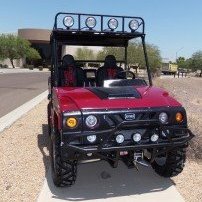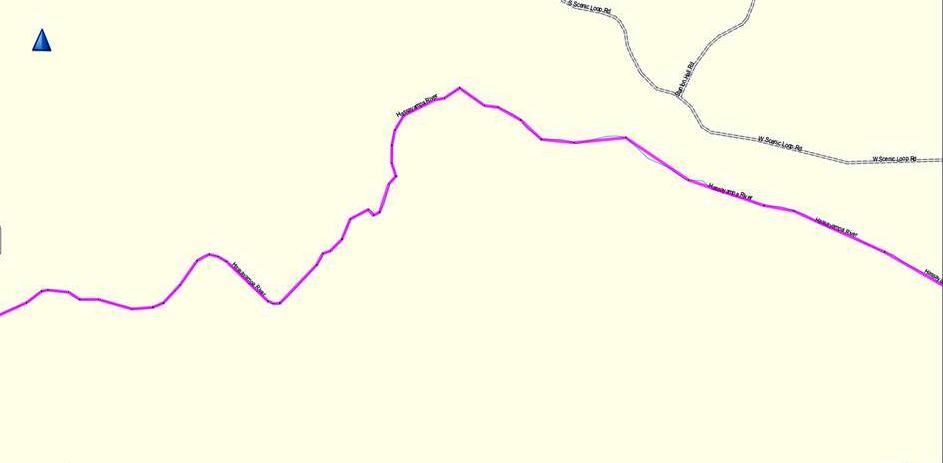-
Posts
262 -
Joined
-
Last visited
-
Days Won
48
Content Type
Profiles
Events
Forums
Gallery
Downloads
Community Map
Everything posted by Dan B
-
I presume your fuel pump doesn't even operate (make noise at least). Depending upon the year model of your Renegade, there's a relay or solid state switch that can prevent your fuel pump from operating. Its location also depends upon your year model.
-
You've replace all the components that can cause loss of spark. Is the gap between the pickup coil and the pulse rotor close? Gap shouldn't be much more than the thickness of a business card. I don't know if it is adjustable on your machine. Check your ground connections. Do you have battery voltages where they should be with the ignition switch on? You may have to find a Hisun dealer. I can only find general diagrams for CDI systems, nothing specific to your machine.
-
I needed the same info for my SxS. I did find the numbers from a few sites but they were all different. But one thing in common was that the weights were split with about 35%-40% on the front axle and about 60%-65% on the rear axle. It's a rear engine SxS. That should give you somewhat of a guide.
-

09 joyner trooper t2 1100cc not starting
Dan B replied to josh mcginnis's topic in Joyner UTV SxS Forum
This may or may not be of any use. My 2014 Renegade has the 1100cc engine (same as the trooper). Mine would start and idle just fine. Then one day it wouldn't. It would crank over, fire, then immediately shut down. I found my battery to be a little below 12vdc. I put a battery maintainer on it (basically a 1 amp battery charger to maintain the charge on the battery). SLA batteries have a habit of discharging over time. Mine starts and runs fine. Presuming your charging system is working, measure the battery voltage with the engine off (should be 12.6vdc). You can see if a jump start will allow it to run and idle. -
Where did you get your spark arrestor? I need one and I need to be assured that it will fit my Renegade 1100cc exhaust system. It should be similar to the Trooper system.
-
I have a Garmin Nuvi 65. Garmin's Base Camp software is free. I don't know what versions of Garmin GPS can use Base Camp. But Base Camp allows me to plot a track and turn it into a route. The track doesn't even have to follow anything but I use it plot a track in dried river bottoms and turn them into a route. I can then download it to my GPS and follow it. The problem I had with Base Camp (and still do) is the steep learning curve. I had a mental block trying to determine the differences between a track and a route as used in Base Camp. Once I got used to it, it seems to be very flexible. But I can't compare it to other GPS systems. The violet line across the middle of the image follows a dried river bottom. I had to create the track with data points, then convert it to a route that I can download it to my GPS and follow it when I go out 4-wheeling. Easy to do once you get over the learning curve. I'm not sure if other GPS systems will allow you to create a non-existent track or route and add it to the GPS database.
-
Just my thoughts. It's possible with some good design engineering. I presume your friend has lost the function of both legs. I don't think putting those controls on the steering wheel would work with any degree of safety. During a turn, the throttle or brake actuators probably won't be in a position to actuate them if needed, especially in an urgent situation. A control yoke (vs a steering wheel) with a throttle actuator could be made to work if you don't have to turn the yoke more than 90 degrees (power steering needed). I would think the throttle (spring loaded to idle) and brake lever would be better accessible from a position on a center console. Certainly won't be able to do any rock crawling because it takes both hands to maintain directional control without power steering. Might be limited to slow speed trail rides (my favorite type of off-roading). Also have to consider the strength of your friends arms and hands. Most people can apply more brake pedal pressure with their legs by pushing against the back of the seat. Here's a link to one advertiser: http://utvpartsandaccessories.com/ There are automobiles with hand controls, but they have power steering and power brakes to make it easier to drive the vehicle.
- 1 reply
-
- 1
-

-
One responder said that high cranking amps (CA) might possibly fry the starter. It won't. A starter will use whatever amps it is designed to draw to start the engine under normal conditions. The battery makes available that current up to its capacity. The battery doesn't force the starter to take all 800 amps. It's just that a battery with a high CA will take longer to recharge and an alternator on a UTV/ATV would have to run several hours to recharge one of those batteries that has been discharged. Although CA isn't specified in this way, you can think of the CA as an undefined limit as to how many times you can start the engine before it is discharged to the point that it won't turn over the engine. An 800 CA battery will work longer than a 80 CA battery (not necessarily 10x longer). A big engine will need a high CA battery vs a small UTV/ATV engine. Alternators on UTV/ATV are low capacity. Too many electronics and lights may take away the alternator's ability to recharge the battery in a reasonable time.
-
Boring is rough cutting the cylinder to a larger size. Honing is removing the rough cuts to make the cylinder walls almost perfectly smooth. A few scratches (not gouges) are left to allow a place for oil to reside to lubricate the piston rings.
-

Help please! 08 T/2 1100...shifter cable replacement nightmare!
Dan B replied to Damage442's topic in Joyner UTV SxS Forum
Here's link where I deduced some of my info. It may be of some help. https://www.manualslib.com/manual/847961/Joyner-Renegade-R2.html?page=34#manual -

Help please! 08 T/2 1100...shifter cable replacement nightmare!
Dan B replied to Damage442's topic in Joyner UTV SxS Forum
This is my guess. It sounds like what you are saying is that the transmission is staying in neutral during the 3rd and 4th gear operation. Have someone operate the gear shift through all 5 speeds. While you're under the vehicle, observe the shift lever operation when shifting from 2nd to 3rd, from 3rd to 4th and from 4th to fifth. I'm thinking that each cable has 3 positions (forward, middle, back). When in any forward gear, one or both of the cables must be away from the middle position (the middle position should be neutral). If both are in the middle position when in 3rd or 4th, then obviously to me at least, the cable that selects 3rd & 4th gear isn't moving the shift lever on the transmission. Check the adjustment and position of that cable at the shift lever and the transmission. Maybe the lever and cable are moving but the shaft on the transmission isn't. Maybe the new cable itself is defective. It's hard to troubleshoot from a distance, so I'm only offering a suggestion. Whenever I work on something and it doesn't work, my first and only suspicion is that I did something incorrectly and it wasn't necessarily caused by a failure. -
You have a few options depending upon its age and general condition. 1. Replace the differential 2. Sell it as-is 3. Part it out. 4. Weld a patch over the hole (if the differential casing is weldable). We can't really decide for you. We can only give you options. Probably #2 or #3 because of it being 11 years old unless you can get a free or very low priced differential.
-
The smell of raw gas in the exhaust tells me one or more of your injectors might be stuck open. The excess fuel pressure after shutdown might be bleeding off into the cylinder making restart difficult. But that would also show black smoke upon start up. If you have a source of compressed air, you might be able to see or feel air coming out the injector. Worth a try.
-
If it's blue smoke all the time (sitting at idle & while driving), it's most likely the oil control rings. A compression test won't expose that problem. But if the oil control rings are bad, it's likely that the compression rings are also bad (might show low compression). If only under heavy acceleration, it's the valve stem seals. The vacuum created under heavy acceleration can cause oil to be drawn past worn valve stem seals. This info is from many websites on automobile engines. ATV/UTV engines aren't much different.
-
I would think any hydraulic system, if vented, should have a very outstanding filter to keep dust and debris out of the system, especially of road vehicles. Here's a l;ink that addresses the placement of the power steering pump's reservoir. http://www.pscmotorsports.com/pdf/tech/reservoir_tips.pdf
-
I'm not a fan of any "cure in a can" solution, but you might try some belt dressing. It makes the belt and pulley have a slightly higher coefficient of friction. If the belt is slipping, that may help. The squealing from belt slipping is different than a whining from low PS fluid level. Another thought of mine. Most PS systems that I'm familiar with have the reservoir at the pump or very close to it. Yous is located quite a distance; probably because of clearance problems with the installation. That could be an issue.to consider. Pumps are of four general types: a combination of high/low pressure with high/low volume. PS pumps are Low Volume High Pressure. They aren't capable of drawing a high vacuum through a long line.
-

2014 Joyner Renegade/Trooper Engine RPM vs Vehicle Speed in 5th Gear
Dan B replied to Dan B's topic in Joyner UTV SxS Forum
My guess: I believe the high RPM requirement has something to do with the relatively low torque of the engine itself. With a higher HP & torque value, the transmission & differential can have lower gear ratios giving better top end speeds at lower engine RPMs. My 6.0L engine can move my 8000lb van at 65 mph with the engine turning at 1800 rpm..- 5 replies
-
- joyner
- engine rpm
-
(and 1 more)
Tagged with:
-
I have a 2014 Joyner Renegade R2 1100cc. I've seen many posts about these bolts sheering off. I don't run my R2 very hard. I live in the desert southwest; not much mud around here. I'm just wondering if I've got a potential of having the same problem or do these bolts only sheer off when running hard through deep mud and such. Did Joyner realize this problem and include 12.9 bolts in later versions, like my model year? Seems like this problem appears in the earlier model years.
- 3 replies
-
- joyner
- differential
-
(and 1 more)
Tagged with:
-
It's a timing mark. The crankshaft gear tooth with a timing punch mark is lined up with the camshaft punch mark. You should get a service manual to ensure they are lined up correctly.
-
I know it has to connect the front axles to the drive train either through the differential or inside the transaxle itself. In my research, it's in the front differential. I'm reluctant to take anything apart at this point since I'm new to 4WD and off-roading. I just want to know if the lever is operating normally. I don't want it to pop out of 4WD on the fly and maybe cause damage. Thank you for any info and insight you can provide.
-
The 4WD lever is "spongy" and doesn't feel like it's locked into the 4WD position even though the transaxle seems to be in 4WD.
-
I'm new to 4WD. I have a 2014 Renegade T2, 1100cc engine, 1700 mi. I'm having difficulty selecting 4WD. I don't want to do anything that might cause damage. The only info I can find is to bring the UTV to a complete stop before selecting 4WD. When I do that, the handle doesn't seem to engage 4WD; it doesn't stay in the down position. Do I have to release the clutch? Do I have to drive forward / backward to make it engage? I don't think I have a transmission problem (no grinding of any gears). Maybe a cable adjustment issue? Thanks in advance for your help.
-

Wiring Connector providers for Kawasaki Mule 4010
Dan B replied to tlutrick's topic in Kawasaki UTV SxS Forum
Yep, I did notice. Many "help me posts" are very old. But I posted anyway in case someone needs to do an emergency repair until they can find the necessary, hard to find parts. -

Wiring Connector providers for Kawasaki Mule 4010
Dan B replied to tlutrick's topic in Kawasaki UTV SxS Forum
What exactly is wrong with the female portion of the connector? It looks okay unless there's a broken connection inside the connector. I presume the male connector is okay. You can replace the pins on many connectors without replacing the housing. If the wire is broken inside, you might be able to pop out the broken one (with a small pin probe) and solder or otherwise remake the connection. I have, in the past, cut off the bad connector, crimped on a matching solderless connector to the individual wires and plugged the wires back into the circuit. Not on any ATV or UTV, but I have done it on my truck because the connector was more expensive that I thought is should be. Desperate times call for desperate measures. -
I'll presume you've removed most of the air from the master cylinder. The usual process of that is to bench bleed the master cylinder before installation. If you use method A, make sure your pedal pumper keeps their foot on the brake pedal and ride it down to the floor while you open the wheel cylinder bleeder valve. Tell him not to take his foot off the pedal until you close the bleeder valve. I make sure I tell my assistant that every time. My assistant may not know how the bleeding process works. Method B, in my opinion, is the best followed by method C which is good. Method C uses a hand operated pump which is less expensive than the setup required for Method B. I wouldn't use D - to easy to introduce air or contaminants.







